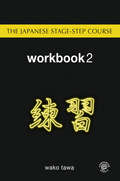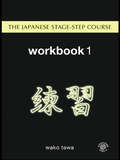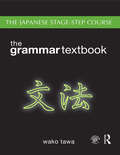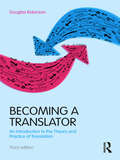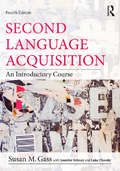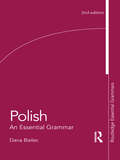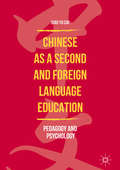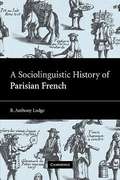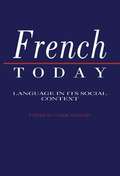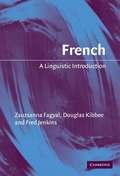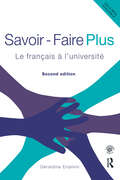- Table View
- List View
The Japanese Stage-Step Course: Workbook 2
by Wako TawaWorkbook 2 of the Japanese Stage-Step Course is designed to be used alongside Stages Two and Three of the Grammar Textbook. It contains conversation, listening, reading and writing exercises along with new vocabulary for each lesson in the textbook to enable students to thoroughly practice the grammatical structures they have learnt. Additional features include: detailed explanation of vocabulary items abundant exercises including sentence as well as discourse practices extensive cross-referencing with the Grammar Textbook Japanese–English and English–Japanese glossary. All the audio material for Workbook 2 is available on CD2.
The Japanese Stage-Step Course: Workbook 2
by Wako TawaWorkbook 2 of the Japanese Stage-Step Course is designed to be used alongside Stages Two and Three of the Grammar Textbook. It contains conversation, listening, reading and writing exercises along with new vocabulary for each lesson in the textbook to enable students to thoroughly practice the grammatical structures they have learnt. Additional features include: detailed explanation of vocabulary items abundant exercises including sentence as well as discourse practices extensive cross-referencing with the Grammar Textbook Japanese–English and English–Japanese glossary. All the audio material for Workbook 2 is available on CD2.
Japanese Stage-Step Course: Workbook 1
by Wako TawaWorkbook 1 of the Japanese Stage-Step Course is designed to be used alongside Stage One of the Grammar Textbook. It contains grammar exercises, along with new vocabulary and conversational, listening, and reading practice for each chapter in the textbook, so that students will be able to thoroughly practice the grammatical structures they have learnt. Additional features include: detailed explanation of vocabulary items information on the system of Kanji abundant exercises including sentence as well as discourse practices extensive cross-referencing with the Grammar Textbook Japanese-English and English-Japanese glossary. All the audio material for Workbook 1 is available on CD1.
Japanese Stage-Step Course: Grammar-Reference
by Wako TawaThe Japanese Stage-Step Course is a fully integrated language course from beginner through to intermediate level combining cohesive grammar instruction with functional examples and practices to build a solid foundation in the four key skills of reading, writing, listening and speaking. The course includes the core text, The Grammar Textbook, Workbooks 1 and 2, Writing Practice Book, audio material on CDs or in MP3 format, and a Companion Website. An understanding of grammar is essential for students aiming to achieve a high level of proficiency in Japanese. Written by an experienced teacher, The Stage-Step Course: Grammar Textbook provides a step-by-step guide to Japanese grammar. With clear, accessible explanations and relevant examples to put each grammatical point into context, the Grammar provides a meaningful framework to develop the key skills of reading, writing, speaking and listening. The book is divided into the following four stages: Stage One: Building a foundation. Stage Two: Towards more complex structures. Stage Three: Adding sophistication. Stage Four: Referencing. Each lesson is accompanied by detailed vocabulary, conversation practice and reading exercises in the separate two workbooks to enable students to put into practice what they have learnt and consolidate their knowledge. The course also includes the Writing Practice Book, audio material on CDs or in MP3 format and a Companion Website.
Japanese Stage-Step Course: Grammar-Reference
by Wako TawaThe Japanese Stage-Step Course is a fully integrated language course from beginner through to intermediate level combining cohesive grammar instruction with functional examples and practices to build a solid foundation in the four key skills of reading, writing, listening and speaking. The course includes the core text, The Grammar Textbook, Workbooks 1 and 2, Writing Practice Book, audio material on CDs or in MP3 format, and a Companion Website. An understanding of grammar is essential for students aiming to achieve a high level of proficiency in Japanese. Written by an experienced teacher, The Stage-Step Course: Grammar Textbook provides a step-by-step guide to Japanese grammar. With clear, accessible explanations and relevant examples to put each grammatical point into context, the Grammar provides a meaningful framework to develop the key skills of reading, writing, speaking and listening. The book is divided into the following four stages: Stage One: Building a foundation. Stage Two: Towards more complex structures. Stage Three: Adding sophistication. Stage Four: Referencing. Each lesson is accompanied by detailed vocabulary, conversation practice and reading exercises in the separate two workbooks to enable students to put into practice what they have learnt and consolidate their knowledge. The course also includes the Writing Practice Book, audio material on CDs or in MP3 format and a Companion Website.
Modern Mandarin Chinese Grammar Workbook
by Claudia Ross Jing-Heng Sheng Ma Baozhang HeModern Mandarin Chinese Grammar Workbook is a book of exercises and language tasks for all learners of Mandarin Chinese. Divided into two sections, the Workbook initially provides exercises based on essential grammatical structures, and moves on to practise everyday functions such as making introductions, apologizing and expressing needs. With a comprehensive answer key at the back to enable students to check on their progress, main features include: exercises graded according to level of difficulty cross-referencing to the related Modern Mandarin Chinese Grammar topical exercises that develop students' vocabulary base. Modern Mandarin Chinese Grammar Workbook is ideal for all learners of Mandarin Chinese, from beginner to intermediate and advanced students. It can be used both independently and alongside the Modern Mandarin Chinese Grammar.
Modern Mandarin Chinese Grammar Workbook
by Claudia Ross Jing-Heng Sheng Ma Baozhang HeModern Mandarin Chinese Grammar Workbook is a book of exercises and language tasks for all learners of Mandarin Chinese. Divided into two sections, the Workbook initially provides exercises based on essential grammatical structures, and moves on to practise everyday functions such as making introductions, apologizing and expressing needs. With a comprehensive answer key at the back to enable students to check on their progress, main features include: exercises graded according to level of difficulty cross-referencing to the related Modern Mandarin Chinese Grammar topical exercises that develop students' vocabulary base. Modern Mandarin Chinese Grammar Workbook is ideal for all learners of Mandarin Chinese, from beginner to intermediate and advanced students. It can be used both independently and alongside the Modern Mandarin Chinese Grammar.
Inheritance and Innovation in a Colonial Language: Towards a Usage-Based Account of French Guianese Creole
by William Jennings Stefan PfänderThis book takes a fresh approach to analysing how new languages are created, combining in-depth colonial history and empirical, usage-based linguistics. Focusing on a rarely studied language, the authors employ this dual methodology to reconstruct how multilingual individuals drew on their perception of Romance and West African languages to form French Guianese Creole. In doing so, they facilitate the application of a usage-based approach to language while simultaneously contributing significantly to the debate on creole origins. This innovative volume is sure to appeal to students and scholars of language history, creolisation and languages in contact.Chapter 3 is published open access under a CC BY 4.0 license.
Inheritance and Innovation in a Colonial Language: Towards a Usage-Based Account of French Guianese Creole
by William Jennings Stefan PfänderThis book takes a fresh approach to analysing how new languages are created, combining in-depth colonial history and empirical, usage-based linguistics. Focusing on a rarely studied language, the authors employ this dual methodology to reconstruct how multilingual individuals drew on their perception of Romance and West African languages to form French Guianese Creole. In doing so, they facilitate the application of a usage-based approach to language while simultaneously contributing significantly to the debate on creole origins. This innovative volume is sure to appeal to students and scholars of language history, creolisation and languages in contact.Chapter 3 is published open access under a CC BY 4.0 license.
Teaching Social Studies to English Language Learners
by Stephen J. Thornton Bárbara C. CruzTeaching Social Studies to English Language Learners provides readers with a comprehensive understanding of both the challenges that face English language learners (ELLs) and ways in which educators might address them in the social studies classroom. The authors offer context-specific strategies for the full range of the social studies curriculum, including geography, U.S. history, world history, economics, and government. These practical instructional strategies will effectively engage learners and can be incorporated as a regular part of instruction in any classroom. An annotated list of web and print resources completes the volume, making this a valuable reference to help social studies teachers meet the challenges of including all learners in effective instruction. Features and updates to this new edition include: • An updated and streamlined Part 1 provides an essential overview of ELL theory in a social studies specific-context. • "Teaching Tips" offer helpful suggestions and ideas for creating and modifying lesson plans to be inclusive of ELLs. • Additional practical examples and new pedagogical elements in Part 3 include more visuals, suggestions for harnessing new technologies, discussion questions, and reflection points. • New material that takes into account the demands of the Common Core State Standards, as well as updates to the web and print resources in Part 4.
Teaching Social Studies to English Language Learners
by Stephen J. Thornton Bárbara C. CruzTeaching Social Studies to English Language Learners provides readers with a comprehensive understanding of both the challenges that face English language learners (ELLs) and ways in which educators might address them in the social studies classroom. The authors offer context-specific strategies for the full range of the social studies curriculum, including geography, U.S. history, world history, economics, and government. These practical instructional strategies will effectively engage learners and can be incorporated as a regular part of instruction in any classroom. An annotated list of web and print resources completes the volume, making this a valuable reference to help social studies teachers meet the challenges of including all learners in effective instruction. Features and updates to this new edition include: • An updated and streamlined Part 1 provides an essential overview of ELL theory in a social studies specific-context. • "Teaching Tips" offer helpful suggestions and ideas for creating and modifying lesson plans to be inclusive of ELLs. • Additional practical examples and new pedagogical elements in Part 3 include more visuals, suggestions for harnessing new technologies, discussion questions, and reflection points. • New material that takes into account the demands of the Common Core State Standards, as well as updates to the web and print resources in Part 4.
Applying Linguistics in the Classroom: A Sociocultural Approach
by Aria Razfar Joseph C. RumenappMaking linguistics accessible and relevant to all teachers, this text looks at language issues in the classroom through an applied sociocultural perspective focused on how language functions in society and in schools—how it is used, for what purposes, and how teachers can understand their students’ language practices. While touching on the key structural aspects of language (phonetics, phonology, morphology, and syntax), it does not simply give an overview, but rather provides a way to study and talk about language. Each chapter includes practical steps and suggests tools for applying different kinds of linguistic knowledge in classrooms. The activities and exercises are adaptable to elementary or high school settings. Many examples focus on the intersection of math, science, and language. Teacher case studies show how real teachers have used these concepts to inform teaching practices. Given the increasing use of multimedia resources in today’s schools, multiple mediums are integrated to engage educators in learning about language. The Companion Website provides a multitude of relevant resources that illustrate the diversity of language functions and debates about language in society.
Applying Linguistics in the Classroom: A Sociocultural Approach
by Aria Razfar Joseph C. RumenappMaking linguistics accessible and relevant to all teachers, this text looks at language issues in the classroom through an applied sociocultural perspective focused on how language functions in society and in schools—how it is used, for what purposes, and how teachers can understand their students’ language practices. While touching on the key structural aspects of language (phonetics, phonology, morphology, and syntax), it does not simply give an overview, but rather provides a way to study and talk about language. Each chapter includes practical steps and suggests tools for applying different kinds of linguistic knowledge in classrooms. The activities and exercises are adaptable to elementary or high school settings. Many examples focus on the intersection of math, science, and language. Teacher case studies show how real teachers have used these concepts to inform teaching practices. Given the increasing use of multimedia resources in today’s schools, multiple mediums are integrated to engage educators in learning about language. The Companion Website provides a multitude of relevant resources that illustrate the diversity of language functions and debates about language in society.
Becoming a Translator: An Introduction to the Theory and Practice of Translation
by Douglas RobinsonFusing theory with advice and information about the practicalities of translating, Becoming a Translator is the essential resource for novice and practicing translators. The book explains how the market works, helps translators learn how to translate faster and more accurately, as well as providing invaluable advice and tips about how to deal with potential problems, such as stress. The third edition has been revised and updated throughout, offering: extensive up-to-date information about new translation technologies discussions of the emerging "sociological" and "activist" turns in translation studies new exercises and examples updated further reading sections a website containing a teacher’s guide, the chapter ‘The Translator as Learner’ and additional resources for translators Offering suggestions for discussion, activities, and hints for the teaching of translation, the third edition of Becoming a Translator remains invaluable for students and teachers of Translation Studies, as well as those working in the field of translation.
Becoming a Translator: An Introduction to the Theory and Practice of Translation
by Douglas RobinsonFusing theory with advice and information about the practicalities of translating, Becoming a Translator is the essential resource for novice and practicing translators. The book explains how the market works, helps translators learn how to translate faster and more accurately, as well as providing invaluable advice and tips about how to deal with potential problems, such as stress. The third edition has been revised and updated throughout, offering: extensive up-to-date information about new translation technologies discussions of the emerging "sociological" and "activist" turns in translation studies new exercises and examples updated further reading sections a website containing a teacher’s guide, the chapter ‘The Translator as Learner’ and additional resources for translators Offering suggestions for discussion, activities, and hints for the teaching of translation, the third edition of Becoming a Translator remains invaluable for students and teachers of Translation Studies, as well as those working in the field of translation.
Second Language Acquisition: An Introductory Course
by Susan M. GassNow in a fourth edition, this bestselling introductory textbook remains the cornerstone volume for the study of second language acquisition (SLA). Its chapters have been fully updated, and reorganized where appropriate, to provide a comprehensive yet accessible overview of the field and its related disciplines. To reflect current developments, new sections on using learner corpora, semantics and morphosyntax (within formal approaches to SLA), sociocultural approaches, gesture, priming research, and chaos theory have been added. Students will also find expanded discussions of heritage language learning, bilingualism, pragmatics, and much more. The redesigned fourth edition of Second Language Acquisition retains the features that students found useful in the current edition but also provides new pedagogical tools that encourage students to reflect upon the experiences of second language learners. As with previous editions, discussion questions and problems at the end of each chapter help students apply their knowledge, and a glossary defines and reinforces must-know terminology. This clearly-written, comprehensive, and current textbook, by expert Sue Gass, is the ideal textbook for the introductory SLA course in second language studies, applied linguistics, linguistics, TESOL, and language education programs.
Second Language Acquisition: An Introductory Course
by Susan M. GassNow in a fourth edition, this bestselling introductory textbook remains the cornerstone volume for the study of second language acquisition (SLA). Its chapters have been fully updated, and reorganized where appropriate, to provide a comprehensive yet accessible overview of the field and its related disciplines. To reflect current developments, new sections on using learner corpora, semantics and morphosyntax (within formal approaches to SLA), sociocultural approaches, gesture, priming research, and chaos theory have been added. Students will also find expanded discussions of heritage language learning, bilingualism, pragmatics, and much more. The redesigned fourth edition of Second Language Acquisition retains the features that students found useful in the current edition but also provides new pedagogical tools that encourage students to reflect upon the experiences of second language learners. As with previous editions, discussion questions and problems at the end of each chapter help students apply their knowledge, and a glossary defines and reinforces must-know terminology. This clearly-written, comprehensive, and current textbook, by expert Sue Gass, is the ideal textbook for the introductory SLA course in second language studies, applied linguistics, linguistics, TESOL, and language education programs.
Polish: An Essential Grammar
by Dana BielecPolish: An Essential Grammar is a user-friendly guide to all the important structures of this fascinating language. Presenting a fresh and accessible description of the language, this engaging grammar uses clear, jargon-free explanations and sets out the complexities of Polish in short, readable sections. Key features include: New chapter on studying an inflected language, including detailed analysis of a typical text Comprehensive descriptions of the parts of speech covered Information presented clearly and logically in table form Wealth of real-life examples Nine clearly-presented appendices. This grammar is an invaluable asset to anyone wishing to master the Polish language as it is spoken today. Two companion books, Basic Polish: A Grammar and Workbook and Intermediate Polish: A Grammar and Workbook, provide more detailed practice in the language.
Polish: An Essential Grammar
by Dana BielecPolish: An Essential Grammar is a user-friendly guide to all the important structures of this fascinating language. Presenting a fresh and accessible description of the language, this engaging grammar uses clear, jargon-free explanations and sets out the complexities of Polish in short, readable sections. Key features include: New chapter on studying an inflected language, including detailed analysis of a typical text Comprehensive descriptions of the parts of speech covered Information presented clearly and logically in table form Wealth of real-life examples Nine clearly-presented appendices. This grammar is an invaluable asset to anyone wishing to master the Polish language as it is spoken today. Two companion books, Basic Polish: A Grammar and Workbook and Intermediate Polish: A Grammar and Workbook, provide more detailed practice in the language.
Chinese as a Second and Foreign Language Education: Pedagogy and Psychology
by Qiao Yu CaiThis book presents key issues in the teaching of Chinese as a second or foreign language (TCSL or TCFL). It investigates how multimedia can help to assist TCSL/TCFL and explores practical effects of multimedia-assisted teaching at secondary schools in the Philippines. It addresses the psychology of TCSL/TCFL and discusses various recurring foreign graduate students concerns when learning academic Chinese in graduate institutes in Taiwan. It examines issues of educational assessment and testing, analyzing the validity of a self-made placement test for an immigrant Chinese program, as well as the psychological characteristics of adult learners and their implications for immigrant Chinese curriculum design. As foreign learners of Chinese grow exponentially, this cutting edge read conceptualizes the educational philosophy of TCSL/TCFL as a distinctive discipline.
Chinese as a Second and Foreign Language Education: Pedagogy and Psychology
by Qiao Yu CaiThis book presents key issues in the teaching of Chinese as a second or foreign language (TCSL or TCFL). It investigates how multimedia can help to assist TCSL/TCFL and explores practical effects of multimedia-assisted teaching at secondary schools in the Philippines. It addresses the psychology of TCSL/TCFL and discusses various recurring foreign graduate students concerns when learning academic Chinese in graduate institutes in Taiwan. It examines issues of educational assessment and testing, analyzing the validity of a self-made placement test for an immigrant Chinese program, as well as the psychological characteristics of adult learners and their implications for immigrant Chinese curriculum design. As foreign learners of Chinese grow exponentially, this cutting edge read conceptualizes the educational philosophy of TCSL/TCFL as a distinctive discipline.
A Sociolinguistic History Of Parisian French (PDF)
by R. Anthony LodgeParis mushroomed in the thirteenth century to become the largest city in the Western world, largely through in-migration from rural areas. The resulting dialect-mixture led to the formation of new, specifically urban modes of speech. From the time of the Renaissance social stratification became sharper as the elites distanced themselves from the Parisian 'Cockney' of the masses. Nineteenth-century urbanisation transformed the situation yet again with the arrival of huge numbers of immigrants from far-flung corners of France, levelling dialect-differences and exposing ever larger sections of the population to standardising influences. At the same time, a working-class vernacular emerged which was distinguished from the upper-class standard not only in grammar and pronunciation but most markedly in vocabulary (slang). This book examines the interlinked history of Parisian speech and the Parisian population through these various phases of in-migration, dialect-mixing and social stratification from medieval times to the present day.
French Today: Language In Its Social Context (PDF)
by Carol SandersFrench Today is a profile of the French language in its social context. British and French linguists examine trends in French throughout the French-speaking world, and address issues around prescriptivism, gender and language, and regional languages and dialects. The collection includes overviews of work done in particular areas and deeper analyses of sociolinguistic questions. One theme is how to represent and interpret data relating to language varieties that have been marginalised. Another concerns the ways in which French is adapting to the future, whether as a language of new technology, or as a vehicular language on the continent. All chapters of this book are in English, with examples and quotations in French, and a mixture of references given in both languages. At the end of each chapter, there are also texts in French, serving as illustration and as pointers to further reading.
French: A Linguistic Introduction (PDF)
by Zsuzsanna Fagyal Frederic Jenkins Douglas A. KibbeeFrench is used on every continent, spoken not only in France but also in Belgium, Switzerland, North America, the Caribbean, Polynesia and Africa. This is a comprehensive and accessible guide to the structure of French, suitable for those with little prior knowledge of linguistics or of the French Language. It clearly introduces the language's history, phonetics (pronunciation), phonology (sound system), morpho-syntax (how words and sentences are formed), pragmatics (how speakers express meaning), and lexicology (the study of word composition and derivation) - with each chapter showing how these aspects are subject to regional and social variation. English translations are provided for all examples, and the book contains an extensive bilingual glossary of linguistic terms, and numerous exercises and essay questions in every chapter. French: A Linguistic Introduction will be welcomed by advanced language learners, and by linguists studying the structure of this important language.
Savoir Faire Plus: Le Français à l’Université
by Géraldine EnjelvinWritten by an experienced tutor, Savoir-Faire Plus is specifically designed to meet the requirements of today’s generation of language undergraduates. Focusing on the life of an Anglophone first year undergraduate studying French in the UK and sharing a house with four francophone students, this engaging textbook provides: a clear, logical structure a blend of communicative, research-based and traditional exercises a wide range of activities covering the four key linguistic skills as well as intercultural skills authentic texts (with extracts from Le Monde, L’Express, Le Nouvel Observateur and Libération) guidance and practical tips for effective and independent learning. Each of the ten chapters consists of four topics-based sections which provide students with a wealth of diverse material allowing them to gain an in-depth knowledge of relevant topical subjects such as regional languages, sustainable development and fair trade, amongst others. Digestible grammar points are integrated throughout and a range of additional exercises are available on the Companion Website allowing students to perfect their language skills. Suitable for both self-study and class use Savoir Faire Plus is the ideal course for all advanced students of French, consolidating knowledge gained at A-Level while supporting the transition to undergraduate study. The Companion Website can be found at www.routledge.com/textbooks/9780415444750
